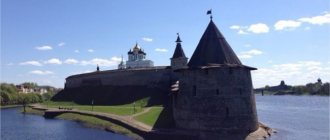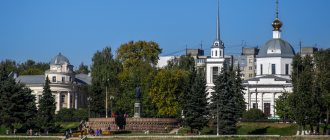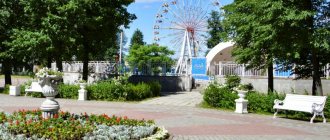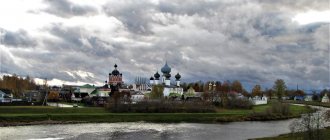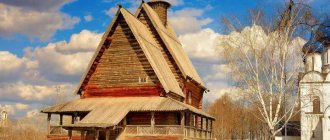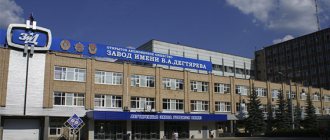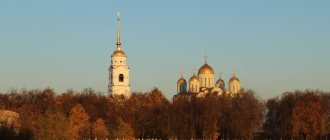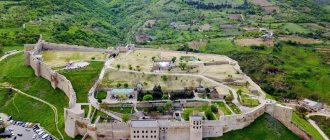| Sights on your own What to see in the vicinity of Tver Reviews of tourists with photos Where to stay in Tver One-day excursions |
Tver is a great option for a day trip. There is everything here in moderation: ancient architecture, beautiful streets, unique museums and monuments, embankments on the Volga and parks. Not only Muscovites and residents of nearby cities come here for the weekend. Tver will be an interesting option for those who have traveled all over the Golden Ring and explored Moscow, who are traveling to St. Petersburg, or vice versa. Her name is certainly known to many, but her appearance is often hidden in obscurity, which makes her even more conducive to acquaintance.
This page will help you with this idea. You will find out what interesting things to see in Tver in one day in summer or winter, as well as what unusual things to find in the surrounding area along the way. The main page about the city will give you a brief overview.
Tver: history of the city, summary
The history of Tver goes back more than 10 centuries, if we focus on the first mention in the chronicles (1135 in the charter and 1208 in the chronicles). Historians joke that when Tver was already a full-fledged city, Moscow was still a remote village in a swamp.
City Day is traditionally celebrated on the last Sunday of June, starting in 1135.
The city received its name from the Novgorodians in honor of the Tvertsa River; for centuries it did not change, only in Soviet times there was Kalinin. Another version is that the name was originally “Tverd” - a stronghold, a fortress on the Volga.
Coat of arms of the city The coat of arms of the city symbolizes the close connection between power and Orthodoxy. Tver is very rich in cultural and religious places - monasteries, churches, chapels, holy springs. The patron saint of the city is Mikhail Tverskoy, who once saved the city, but was then brutally tortured in the Golden Horde, for which he was canonized.
Another key figure is Afanasy Nikitin, a Tver merchant of the 13th century, who made an outlandish journey to India in those years and described it in his diaries “Walking across Three Seas.”
In the 12th-13th centuries, Tver claimed to be the capital of Ancient Rus', but could not compete in treachery with the Moscow princes. In the Middle Ages, Tver was a small but well-defended fortress at the confluence of the Volga and Tmaka, now it is the historical center of the city.
The next significant historical era for Tver is associated with Catherine. The Empress, on her trips from Moscow to St. Petersburg, stopped in Tver - a luxurious Travel Palace was built for her. Tver gradually changed its architectural appearance from wooden to stone; the city center was built up with remarkable merchant houses that have survived to this day.
Next is the imprint of the Soviet era, the era of Stalinism, the last years - Tver accepted everything and organically digested it.
To understand about Tver, its history and significance in the formation of the Russian state, it is not necessary to read heavy volumes of research by historians or literary scholars; a lot can be gleaned from ancient Russian literature.
Tver Kremlin
The fortification was destroyed and rebuilt many times. The first wooden fortress was built in the 12th century, and that’s when the history of Tver began.
In 1238, the Mongol-Tatars arrived and did a fair amount of mischief, but most importantly, they razed the fortifications to the ground. They were restored. And at the end of the same century, the Transfiguration Cathedral was built.
The Kremlin finally burned down in 1763. It was not restored again - there was no need for it now, and only earthen ramparts remained from it. But lovers of history and all antiquities, thinking about what to see in one day in Tver, are interested in just such ruins. You can explore them independently or under the guidance of guides.
If you like the stories of a professional historian, order the interesting story “Tver Yesterday and Today.” The guide will tell you about the events of the Middle Ages, about enemy raids and other terrible things.
What to see in Tver in 1 day
The city is located on both banks of the Volga, but at the same time it is quite compact, which will be a definite plus for you. Moving between interesting objects will not take much time. The main points of tourist attraction can easily be visited in one day, if you do not delve into the study of the exhibitions of local museums and exhibition centers. It is best to start your introductory walk early in the morning so that you have time to see all the interesting things.
For example, the Tver Kremlin. It is a must visit. This is generally the best place to start your acquaintance with the city. Nearby there is a magnificent example of 18th century architecture - the Imperial Travel Palace, in the premises of which there is an art gallery. From here, take a leisurely step in the direction of the Tver Academic Theater. Next, head towards Lenin Square and the Cathedral of the Ascension of the Lord. The next point of your walk will be Sovetskaya Square and the Museum of Communications. You can reach it along the street, which is also called Sovetskaya. Along it you will go further towards the museum and exhibition center and two religious buildings. Not far from each other are the Catholic Church and the Cathedral Mosque, built in the New Moorish style.
From here it’s just a couple of steps to the park with the unusual name “Vokzal”. On its territory there are abandoned historical buildings, including the buildings of the provincial hospital of the 18th century. The architecture is in disrepair, but if you are interested in studying such objects, then you will definitely like it here. If you prefer attractions of a different kind, then straight from the Catholic Church follow towards the Novovolzhsky Bridge. Along it you will cross to the other side of the Volga, where there is also something to explore. The Museum of Tver Life, the River Station and other interesting objects deserve attention.
Trekhsvyatskaya street
Tverskoy Arbat. The street is considered one of the most beautiful and well-maintained. Trekhsvyatskaya is closed to cars and is intended only for leisurely walks and pleasant pastime - the most important city events take place on the street. There are always a lot of artists, musicians and other performers there. Here you can buy souvenirs and dine in cozy cafes and restaurants.
The street got its name because it previously led to the Three Saints Monastery. Now there are two- and three-story mansions on it from the century before last.
Historical Tver: places the country is proud of
So that a walk around historical Tver does not pass as a simple contemplation of beautiful houses and laconic monuments (although this will bring pleasure), it is worth learning at least a little about what makes local cultural sites so remarkable.
We recommend reading:
What to see in Astrakhan
By the way, everything more or less significant is located quite compactly and fits within the framework of a simple route. In this case, attractions will open one after another, the only thing is not in the chronological order of occurrence and not in order of importance.
How to get to Tver
If you are leaving from Moscow, the journey will take 1.5-3 hours. The exact time depends on which train tickets are purchased for.
If this is a high-speed train that makes a minimum number of stops along the way, then an hour and a half is enough to get to your destination.
As for comfort, you can purchase tickets for a carriage with seats, a reserved seat or a compartment. You can even book a SV. But you won't have to spend much time on the road. It’s better to save money and spend this money on walks around Tver. Although, you decide for yourself how you want to get there.
Volga embankment in Tver
Each section along the Volga in the territory has its own name. In the city center, there are two embankments on the right and left banks of the river.
From the end of Sovetskaya Street it is convenient to go to one of the right banks - Stepan Razin embankment. Among its important details are the classical buildings and the monument to Andrei Dementyev, a poet, writer, editor of some famous Soviet publications and a native of Tver.
Behind the Novovolzhsky Bridge it continues with the Mikhail Yaroslavich embankment. It is the most visited, as it is located near the City Garden of Tver and the Palace Garden in front of the Imperial Palace. It offers a wonderful view of the openwork trusses of the Starovolzhsky Bridge.
On the upper promenade there is an unusual monument to A.S. Pushkin: the poet seemed to have stopped to rest at the embankment fence and remained here forever in stone. In the City Garden you will find a Ferris wheel and another monument to Mikhail Tverskoy. Pay attention to the Zvezda cinema and the Voroshilov Riflemen's House located right there - architectural monuments of the pre-war years. A staircase leads to the lower tier; pleasure boats depart from its pier in the summer.
The left bank embankment is named after Afanasy Nikitin, and a monument to him is erected here. Afanasy Nikitin is a famous Tver navigator of the 15th century who visited India. From here on the pedestal is the bow of the ship, decorated with the head of a horse. Behind it stands the Church of the Three Confessors. The Zavolzhsky Park runs along the promenade - a pleasant place for leisurely exercise, viewing the panorama of the other side, or even relaxing on the City Beach in the summer. There is another monument in it - to the Submariners of the Second World War.
At the confluence of the Tvertsa River and the Volga stands an outstanding landmark on the left bank - Tver River Station, built in 1938. In its center there are two round parts with columns. The beautiful, majestic building, unfortunately, has not been used for a long time and is therefore actually ruins. It is hidden from the water by an alley, in front of which there is an art object in the form of the letters “TVER”.
Across Tvertsa there is a cozy but little popular coastal street called the Volga River embankment. Along it stand old and new mansions and the St. Catherine's Monastery.
Sights of Tver
People go to Tver to see the luxurious Travel Palace with an art gallery and the unusual Proletarka Courtyard (Morozov Barracks), admire the classic “solid facade” in the reflection of the Volga, find lost (and not always well preserved) houses in the northern Art Nouveau style, climb the legendary “ Ryumka” is one of the ugliest long-term construction projects of the Soviet period, according to the Russian Beyond project.
Sights of Tver on the map
Tver Kremlin and excursion in VR glasses
Imagine, Tver once had its own Kremlin. But we know little about him. The Tver Kremlin burned down during a terrible fire on May 12, 1763. Its memory is preserved only by local guides and local historians, and by the not completely destroyed ditch, which became an alley in the City Garden.
If you want to plunge into the atmosphere of Tver in the mid-18th century and imagine what the Kremlin looked like, take a tour of the city using virtual reality glasses: tver-tour.ru
Imperial Travel Palace
- Construction time: 1764-1766
- Style: classicism
- Author of the project: P. R. Nikitin
The main attraction of the city and the pride of Tver residents.
Imperial Travel Palace in Tver
The palace was named Imperial because in the 19th century, members of the Romanov family lived there for three years - the granddaughter of Catherine the Great and her husband, and the emperors themselves often stayed there. The Tver residence was called in those years the third Small Courtyard.
Initially, the palace was built as a route. Catherine herself stayed there in 1767 on her way from St. Petersburg to Moscow. At the beginning of the 19th century, the palace was rebuilt by Karl Rossi for the residence of the granddaughter of the Empress, Catherine Pavlovna, and her husband, the Tver governor Georg of Oldenburg.
The palace features restored historical interiors with 19th-century furnishings and a rich art gallery with paintings by Russian artists: Aivazovsky, Levitan, Shishkin, Surikov. We recommend taking a tour of the palace with a visit to the art gallery.
- Address: st. Sovetskaya, 3
- Approximate inspection time: 2 hours
- See prices, excursions and visiting rules here: gallery.tverreg.ru
After visiting the palace, take a walk through the Palace Garden, especially if you find yourself in Tver during the warm season. Look into the greenhouse and through the garden you will go out to the Volga.
Morozov barracks and "Paris"
An excellent example of Art Nouveau and red-brick neo-Gothic of the late 19th and early 20th centuries, the quintessence of the beauty of architecture and the ugliness of everyday life.
Barracks "Paris"
The Morozov barracks are named after their creator, industrialist and philanthropist Savva Morozov, who at the age of 89 set up textile production in Tver.
Savva Vasilyevich Morozov bought the share of one of the Moscow merchants, who decided to open several manufacturing establishments in Tver on the right bank of the Tmaka, and with the help of his sons began to develop this business. It is surprising that at such an advanced age he was running a business and had an “insight” for profit.
The barracks were built as housing for factory workers. In addition to residential buildings, a People's Theater, a hospital, a maternity hospital and even an observatory were also built (the astronomical tower was preserved, but without a telescope).
The Morozov town won first place at the World Exhibition in Paris in 1900 as the best settlement for workers.
In all barracks, no two buildings are alike.
People still live in the quarter, but it is a very specific place. Squalor and neglect, communal living, lack of proper maintenance of beautiful architectural monuments, and the presence of asocial elements have turned this area into a very unique corner of the city.
The largest and most prosperous of the barracks is called “Paris” (the second name is the House named after Varvara Morozova).
- Time of construction: 1910–1913
- Address: st. Proletarka Yard, 70
Tours are now offered to the Morozov barracks:
- instagram.com/gid_veronika_ester
- instagram.com/morozovskiy_tver_official
Nativity of Christ Monastery and Berg Barracks
From the Morozov Barracks, walk to the Nativity Convent and admire its classical-style ensemble. The monastery itself is very ancient, there is a mention of it in the chronicles of 1514. But the buildings of the surviving churches are of later construction: Rozhdestvensky, 1820, and Resurrection, 1913. The oldest is the Gate of the Savior Church (1805).
Nearby there is another barracks - Berga (Spartak St., 43-45). They appeared in Tver before the Morozovskys. Pay attention to the unusual design of the windows (this technique was also used during the construction of the Morozov town). The building was built by architect Karl Schmidt.
“Glass” or Tver “Leaning Tower of Pisa”
This is what people call a high-rise business center building with a panoramic restaurant at the top.
“Ryumka” is the tallest building in the center of Tver.
It was built as a hotel for the 1980 Olympics (in the shape of a torch), but was never completed. Information began to appear about the erosion of the foundation by groundwater, about the tilt and tilt of the structure. The construction was mothballed. For a long time it was the most notable long-term construction project in the city.
Later it was turned into a radio tower, and now there is a business center, a hotel and the Panorama restaurant on the 22nd floor. The observation deck is located on the 24th floor; you can go up there for a fee.
Address: Smolensky lane, 29.
Tver Mosque
Next to “Ryumka” there are a mosque and a church opposite each other. The mosque is old, 1906 (Smolensky lane, 28). The church appeared here not so long ago - in 2002 (Sovetskaya St., 63). Behind them is the Voksal park , one of the oldest in Tver, where several buildings in the Art Nouveau style have been preserved (they are in poor condition).
Meshchanskaya Sloboda
Wooden carved house in Meshchanskaya Sloboda / photo by Veronica Ester
In the center of the city there is a reserved corner where you can feel the spirit of the old, wooden, almost disappearing Tver. In this quarter, wooden buildings, carved and beautiful, have been preserved. These are Serebryannaya, Starororobevskaya, Mednyakovskaya streets. Try to find a synagogue there built in 1912.
Unfortunately, there are fewer and fewer wooden houses every year. Elite expensive cottages are replacing decaying antiquities.
Meshchanskaya Sloboda is located not far from Ryumka. Also in this area is the Plyushkin Museum (you can combine a visit there with a walk through the old quarter and a visit to the observation deck).
Tver "Swallow's Nest"
- Time of construction: late 1870s
- Author: Tver architect P. F. Fedorov
The building of the Avaevskaya almshouse
The former Avaevskaya almshouse is older in age than the famous castle on the rock in Yalta. A two-story house with a bay window turret and medieval stylization appeared in Tver in the late 1870s, while the Crimean castle was built by A. Sherwood in 1912. In 1884, with funds bequeathed by the Tver merchant Vasily Petrovich Avaev, an almshouse was set up in it.
The building appears in the film “State Councilor” of 2004. At the moment, restoration is underway, but you can examine the house from the outside.
Address: st. Krylova, 20/29.
Monuments of Tver
There are several dozen monuments in Tver. We would like to highlight two of the most iconic ones, associated specifically with Tver.
Monument to Mikhail Krug
- Author of the project: Vadim Tsyganov (husband of singer Vika Tsyganova)
- Installed: 2007
The sculpture of the main chansonnier of Russia in the 90s on Radishchev Boulevard divided the Tver public into two irreconcilable camps. Some are proud of their fellow countryman, others believe that the monument does not deserve a place in the city center. There were cases of vandalism: once a guitar was cut off at the monument, paint was poured over it several times.
If you go down Trekhsvyatskaya, then at the very end you will reach the Circle Museum (6/1 Tchaikovsky Ave.).
Monument to Afanasy Nikitin
- Author: G. A. Zakharov
- Installed: 1955
Monument to Afanasy Nikitin
There are only three monuments to the famous traveler and pioneer in the world. One of them stands in Tver, because it was from here that Afanasy Nikitin went on his “Walk across the Three Seas.”
The second monument is located in the city of Feodosia (Crimea), and the third is in India. All three monuments form a kind of “ring” - the route of the famous Tver traveler.
Nikitin’s sculpture stands on the left bank of the Volga, on the embankment of the same name, in the Zavolzhsky district of the city. Nearby there is a panoramic platform with views of the Volga and the other bank.
Strelka, Assumption Cathedral and the ruins of the River Station
River station in Tver before the collapse.
If you go a little further, you will come to the spit - to the place where the Tvertsa River flows into the Volga. On the spit stands the old Assumption Cathedral (1722) - the only surviving church of the destroyed Otroch Assumption Monastery.
The River Station was built on this site in 1938. But he, too, was not destined to stay here for long. It collapsed quite recently - in August 2022. Although the building was luxurious, Stalinist Empire style, the pride of the city. Perhaps it will someday be restored, but for now you can only contemplate its ruins.
At this point, major shipping on the Volga ends. Large ships do not go upstream.
the Romanov School, next to the Swallow's Nest , a building with an impressive appearance in the Northern Art Nouveau style. Built in 1912-1913. Now it houses the children's art school named after. Mussorgsky.
Address: st. Saltykova-Shchedrina, 27.
Cinema "Zvezda"
The cinema building was built in 1937. The architect is V.P. Kalmykov, he also built the Rodina cinema in Moscow. The Moscow cinema, although recognized as a cultural heritage site, was subject to a reconstruction program in 2020. Muscovites know this story, during which many cinema buildings, including monuments of Soviet architecture, were demolished under the guise of restoration and improvement.
“Star” is one of the best examples of late constructivism. The building was built in the shape of binoculars on the site of Peter's house. The cinema is still operating; it is one of the largest cinemas in the Tver region.
Address: Stepan Razin embankment, 1.
Stepan Razin Embankment
This beautiful embankment is located in Tver on the right bank of the Volga. It stretches for 1.2 km through the historical center of the city from the stadium to the City Garden. The first stone houses on this site began to be built in the middle of the 18th century. For the development of the embankment, the “solid façade” style, which was used in St. Petersburg, was used.
Today, Tverskaya embankment, named after the leader of the uprising, Don Cossack Stepan Razin, is a monument to urban planning. Many of the houses located on this street were originally one-story, but later second floors were added. In addition to the former merchant buildings on the S. Razin embankment, there are noble mansions, the “House of the Voroshilov Riflemen” - an architectural monument of the Stalin era, and the “Zvezda” cinema, built in the style of late constructivism.
Address: Stepan Razin Embankment, Tver, Russia.
Starovolzhsky Bridge
The first city bridge across the Volga. Its length is almost 216 meters. Its appearance is reminiscent of the Freedom Bridge in Budapest.
The bridge is divided into two parts: automobile and pedestrian. In the 30s of the 20th century, a tram line was launched, and later a trolleybus line. At the end of the 20th century, the bridge was completely reconstructed: all wooden coverings were replaced with asphalt concrete ones, the roadway was widened, and all supporting structures were additionally strengthened.
Afanasy Nikitin Embankment
The river station is located on the Afanasy Nikitin embankment. From here you can go on a boat trip, but first you should take a walk and see the sights. This territory, called Zavolzhsky Posad, was inhabited and rebuilt since the 14th century. When all the wooden buildings burned down during the fire of 1763, the residents built stone houses here. In the mid-13th century, the Otroch Monastery was founded on the shore. In the 30s of the last century it was destroyed due to the reorganization of space. Of the monuments, only the Cathedral of the Assumption of the Blessed Virgin Mary remains. This is where the countdown of buildings located on the embankment begins.
The temple was built in 1722 in the Naryshkin Baroque style. In 1799-1800, its interior walls were decorated with paintings by icon painter Matvey Chelpovsky. In Soviet times, the cathedral was closed; its premises housed the exhibition halls of an art gallery. In 1994, the temple was returned to the Russian Orthodox Church, and its complete restoration was carried out, but in the period from 2005 to 2010, despite public protests, the ancient painting was completely destroyed. The temple is active and services are regularly held there. Nearby is the River Station, which occupied most of the former monastery courtyard.
On the embankment there is the Church of the Resurrection (Three Confessors). It was built in 1731. During Soviet times, the frescoes and two tiers of the bell tower were destroyed. In the 90s, restoration work was carried out, after which the temple was opened to the public. A monument to Afanasy Nikitin is erected in front of it. It was created by sculptors S.M. Orlov and A.P. Zavalov designed by architect G.A. Zakharova. The opening took place in 1955.
We recommend reading:
The most beautiful places in Crimea
A little further is the first building in Tver built in the classicist style. This is the house (No. 44) of the Zubchaninov merchants, in which at one time the Theological School was located. In the neighboring house there is an Art College named after. Venetsianova. There is a monument to submariners in the park on the embankment. The infrastructure of the park is conducive to walks; the park area has attractions and a small Ferris wheel. There is a stage area designed in the form of an amphitheater, 2 sports grounds and 4 children's playgrounds. On the Afanasy Nikitin embankment there are the Golden Plaza, Hyde Park, and Governor hotels.
The River Station building, built in 1938, is also of interest to lovers of architectural solutions of the Stalin era. It is located at the confluence of the city’s two main rivers – the Volga and Tvertsa. Today, restoration and restoration work is being carried out here (in 2022 the roof collapsed, then part of the rotunda collapsed). Cash desks are only open during the navigation period. Excursion boats depart from the pier.
Churches and temples
Chapel of Mikhail Yaroslavich Tverskoy
Located on Memory Island. It is a church erected in honor of the Grand Duke of Tver, who reigned in the 12th-13th centuries.
Cathedral of the Ascension
Address: st. Sovetskaya, 26 Tel.: Website: https://vosnesenie.ru/ Opening hours: daily from 08.00 to 19.00 (check the start time of each service on the website)
The temple was repeatedly damaged by fire, but parishioners always restored it. The white stone cathedral in the neo-Russian style, as it can be seen today, was rebuilt in 1763.
Assumption Cathedral
Address: emb. Afanasia Nikitina, 1 Tel.: Website: https://www.otrochmontver.prihod.ru/ Opening hours: daily from 08.00 to 19.00 (the start time of the service may vary, check the information on the website)
The ancient temple is mentioned in chronicles at the very beginning of the 12th century. It was here in the 16th century that Metropolitan Philip, who was conducting his service, was strangled by Malyuta Skuratov.
White Trinity Church
Address: st. Troitskaya, 38 Tel.: Opening hours: from 08.00 to 19.00 (depending on the service)
Built in 1564, it is an architectural monument. Surprisingly, the oldest church in the city did not stop working even during Soviet times. And not far from her, in an inconspicuous house with old shutters, a clergyman secretly baptized children, at a time when this was prohibited in the USSR.
Nativity of Christ nunnery
Address: 1st Proletarsky village, 1 Tel.: Website: https://xrm.tver.ru Opening hours: daily from 07.00 to 19.00
Mentions of this monastery are found in chronicles from 1514, and the main temple was built in 1810. Near it, cells with a chapel and an unusual arch are still preserved, where the echo reflects your voice with many echoes.
Alexander Nevsky Church
Address: st. Comintern, 18a Phone: Website: sobor-nevskogo.ru
The church project was approved by Emperor Alexander II back in 1879, but due to lack of funds it was not implemented then. But 9 years later they remembered the drawings and decided to coincide the construction of the temple with the miraculous rescue of the imperial family during a train crash in 1888. Three years later the work was completed.
Services were held in the church until 1929. Then they organized a warehouse in it, later rebuilt it into a store and apartments, and then completely dismantled it.
The new building was founded in 2010. The relics of the Great Martyr Thaddeus, Archbishop of Tver, were placed at the base of the temple. The opening took place 6 years later.
See the city of Tver from the Volga River
Between the two central bridges near the Zvezda cinema, go down to the pier and buy a ticket for the river bus and ride on a boat (40 minutes or 1.5 hours). And during this time, imagine all the exhausting burden of the barge hauler - the Tver region was especially “loved” by barge haulers for its numerous shallows and oxbow lakes.
Or you might be surprised how the picturesque banks of the Volga are built up with numerous military units, factories, factories and industrial sites, and not with beautiful houses and parks.
Or just relax, exposing your face to the cool breeze and watching houses, districts, and bridges float by.
Before this, of course, go to the cafe “Arzu” (popularly “Dead Horse”), popular among Tver residents, it is located on the side of the cinema, buy takeaway food, go to the slope of the shore and have a picnic on the grass, watching the seagulls and fishermen.
Goat Museum
The goat is the symbol of the city. For many centuries, craftsmen made a variety of things from goat skin, which were sold throughout Russia. And all because there is a legend.
One day a goat, having escaped from its owner, was walking around the city and somehow wandered into the bell tower. There he got entangled in the ropes and began to kick. The ringing of the bells woke up the townspeople and warned them of danger - enemies were approaching the city.
Now the museum has collected almost 3.5 thousand exhibits - figurines of goats. They are made from a variety of materials: glass, straw, porcelain, fabric, wood.
Each excursion is a small interactive performance with jokes and funny rhymes. Young children will especially enjoy this museum! It is open every day (except Monday) from 10:00 to 18:00, and on Sunday from 12:00 to 19:00. Entrance to the museum is free.
Climb the tallest building in Tver
Delovoi, formerly a hotel built for the 1980 Olympics, is the tallest building in the city. Local residents aptly nicknamed it “The Glass” and “The Corn Cob” and they themselves are wary of going up to the observation deck and will definitely tell the legend: the building was designed with violations, it could collapse at any moment, and the architect of this miracle lives very close by in a townhouse and calculated, that if the tower falls, his house will not be damaged.
Fans of extreme sports, of course, will only be encouraged by such a legend, but in general, the bird's eye view of the city is worth a visit to Tver.
The business has a café with an emphasis on a panoramic view of the city.
Mikhail Krug Museum
No matter how you feel about chanson, it is worth recognizing that this musical genre has become quite popular in Russia. Its most prominent representative remains Mikhail Krug, who was born and raised here. The singer often performed at the city's Lazurny entertainment complex, and it was here that the museum was organized.
The exhibition is small, but deserves the attention of fans of the talented artist. Numerous personal photographs from concerts, the singer’s full discography and posters are collected here.
Main exhibits:
- The white hat that Krug often wore on stage;
- Guitar;
- Cane;
- A mug that was always in the dressing room.
The museum is open every day, it opens after 21:00.
Walk along Tver's Champs Elysees
Tchaikovsky Avenue among thinking young people (several buildings of the state university are located in that area) was called the Champs Elysees.
To get the full impression, it is worth walking along Tchaikovsky from Kaposvár Square to the railway station on the left side. At the very beginning of the route, go up to the top floor of the Geophysics building and look out the window - the street in perspective really resembles a Parisian one.
Considering that Stalin is the last style of architecture, as significant as classicism or empire style, a walk along the Tver Champs Elysees will bring pleasure in looking at the elegant houses of the 50s of the last century.
On the way, near the Faculty of Philology, you will meet a monument to Cyril and Methodius, who bashfully turned away from the building in reproach to the modern state of science.
You can finish your walk in the station waiting room. It is notable for the fact that for several years in a row it has won the competition for the title of the best waiting room and is a luxurious winter garden with hundreds of plants, singing birds, and beautiful benches. There is also a museum room on the platform where the imperial family stayed during trips on the October Railway.
Sources:
Author of the publication
offline for 3 months
Proletarka's Courtyard
This small “city within a city” was built in the mid-19th century for workers and their families. It is also called the Morozov Barracks - named after the businessman Savva Morozov. The complex included not only residential buildings, but also a hospital, laundry, pharmacy, and theater. There was even a park, although in those days city gardens were not laid out for ordinary workers. In many ways, all this appeared thanks to Morozov’s wife, who was very worried about the workers of the local factory.
Proletarka's yard today is sometimes called the Tver slums or communal hell. People still live here, despite the disrepair of the buildings. And although it’s scary to enter the Morozov barracks, and most of the “apartments” have long turned into brothels, guests of the city every now and then look into this gloomy area. It could serve as a good setting for a historical or horror film.
Yard of Proletarka in Tver
Other attractions are the Nativity of Christ Monastery, the botanical garden, the Church of John the Baptist, the Starovolzhsky Bridge, the Museum of Tver Life, the Tver Art Gallery.
You can see Tver in one day, accompanied by a guide, by choosing an unusual tourist program.

